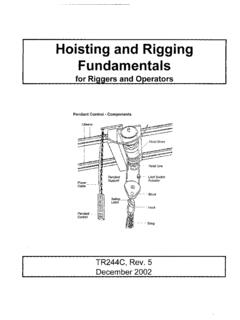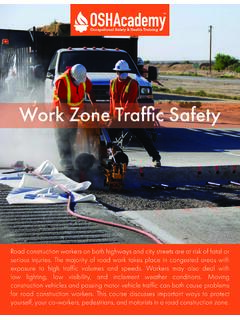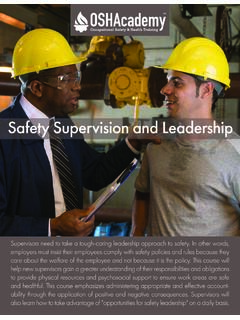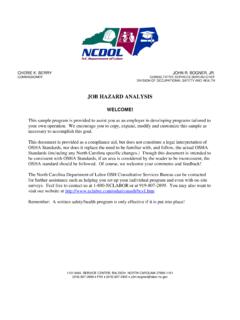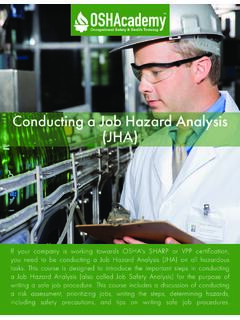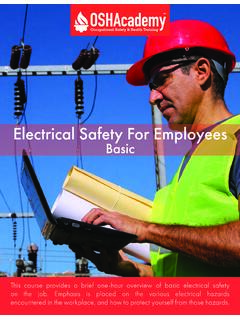Transcription of Confined Space Program - OSHA Training | …
1 Employees who work in confined spaces face increased risk of serious physical injury. Hazards involving a confined Space include entrapment, engulfment, and dangerous atmospheric conditions. As a result, employees who conduct work within confined spaces must be properly trained. This course presents information on the definition of a confined Space , hazards of a permit-required confined Space , and alternative procedures to control atmospheric hazards. The written Program and entry permit system, rescue and emergency services, and importance of Training are also Space Program This page intentionally blank OSHA cademy Course 713 Study Guide Confined Space Program Copyright 2017 Geigle Safety Group, Inc.
2 No portion of this text may be reprinted for other than personal use. Any commercial use of this document is strictly forbidden. Contact OSHA cademy to arrange for use as a Training document. This study guide is designed to be reviewed off-line as a tool for preparation to successfully complete OSHA cademy Course 713. We hope you enjoy the course and if you have any questions, feel free to email or call: OSHA cademy 15220 NW Greenbrier Parkway, Suite 230 Beaverton, Oregon 97006 + Disclaimer This document does not constitute legal advice.
3 Consult with your own company counsel for advice on compliance with all applicable state and federal regulations. Neither Geigle Safety Group, Inc., nor any of its employees, subcontractors, consultants, committees, or other assignees make any warranty or representation, either express or implied, with respect to the accuracy, completeness, or usefulness of the information contained herein, or assume any liability or responsibility for any use, or the results of such use, of any information or process disclosed in this publication.
4 GEIGLE SAFETY GROUP, INC., DISCLAIMS ALL OTHER WARRANTIES EXPRESS OR IMPLIED INCLUDING, WITHOUT LIMITATION, ANY WARRANTIES OF MERCHANTABILITY OR FITNESS FOR A PARTICULAR PURPOSE. Taking actions suggested in this document does not guarantee that an employer, employee, operator or contractor will be in compliance with applicable regulations. Ultimately every company is responsible for determining the applicability of the information in this document to its own operations. Each employer s safety management system will be different.
5 Mapping safety and environmental management policies, procedures, or operations using this document does not guarantee compliance regulatory requirement. Revised: July 31, 2017 This page intentionally blank Course 713 Contents Course Introduction .. 1 Course Goals .. 1 Module 1: Confined Space Basic Concepts .. 3 Introduction .. 3 What is a confined Space ? .. 3 What is the difference between these two definitions? .. 4 Reasons for Entering Confined Spaces .. 4 Permit-required confined spaces (PRCS).
6 4 Examples of confined spaces that could become permit spaces .. 5 Where confined spaces are found .. 5 What is confined Space entry ? .. 6 Using alternative entry procedures .. 7 Flow Chart .. 8 Module 1 Quiz .. 9 Module 2: Confined Space Program Elements .. 11 Introduction .. 11 Elements of the confined Space Program .. 11 Workplace Evaluation Procedures- What is the written plan? .. 11 Identify Confined Spaces .. 12 Warning signs .. 12 Hazard identification procedures .. 12 Procedures and practices .. 13 Entry permit system.
7 14 Course 713 Employee Training for authorized entrants, attendants, and entry supervisors .. 14 Controlling confined Space hazards .. 14 Equipment and Resources for safe entry .. 14 A measurement system .. 15 Confined Space Rescue Plan .. 15 Annual Program Evaluation .. 15 Module 2 Quiz .. 16 Module 3: The Confined Space Entry Permit Purpose of Confined Space Entry Permit .. 18 Sections of the entry permit .. 18 Permit validity .. 19 Cancelling entry permits .. 19 Entry permit maintenance .. 19 Sample Permit.
8 20 Module 3 Quiz .. 21 Module 4: Confined Space Atmospheric Hazards .. 23 Introduction .. 23 Confined Space hazard categories .. 23 Hazardous atmospheres .. 23 Acceptable atmospheric conditions .. 24 Oxygen deficiency .. 24 Oxygen enrichment .. 25 Combustible and flammable gases .. 25 Lower Flammability Limits (LFL) and Lower Explosive Limits (LEL} .. 26 Upper Explosive Limit (UEL) and Upper Flammability Limit (UFL).. 26 Course 713 Flammable Range .. 26 Combustible dust atmospheres .. 27 Toxic atmospheres.)
9 27 Irritant/Corrosive Atmospheres .. 29 Examples of Corrosives .. 29 The Material Safety Data Sheet (MSDS) .. 29 Monitoring and testing for hazardous atmospheres .. 30 The "OFT" order of testing in confined spaces .. 31 Atmosphere Sampling Procedure .. 31 Direct-reading testing instruments .. 32 Purchasing monitoring equipment .. 33 What does "immediately dangerous to life or health" (IDLH) mean?.. 33 Permissible Exposure Limits (PELs) .. 34 Module 4 Quiz .. 35 Module 5: Non-Atmospheric Hazards .. 37 Types of physical hazards encountered in confined spaces.
10 37 Mechanical Hazards .. 37 Skin Contact Hazards .. 37 Limited Access Hazards .. 38 Slip and Trip Hazards .. 38 Fall Hazards .. 39 Personal Fall Protection System .. 39 Work Environment Temperature Related Hazards .. 39 Communication Problems .. 41 Course 713 Excessive Noise Hazards .. 41 High-Pressure Hazards .. 42 Electrical Hazards .. 43 Vibration .. 44 Impact Hazards .. 44 Entrapment hazards .. 45 Engulfment .. 45 General/Physical .. 45 Module 5 Quiz .. 47 Module 6: Controlling Confined Space Hazards.
